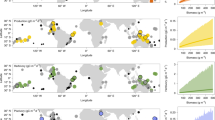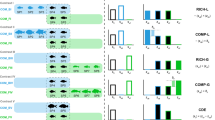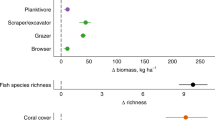Abstract
Positive relationships between biodiversity and ecosystem functioning (BEF) highlight the importance of conserving biodiversity to maintain key ecosystem functions and associated services. Although natural systems are rapidly losing biodiversity due to numerous human-caused stressors, our understanding of how multiple stressors influence BEF relationships comes largely from small, experimental studies. Here, using remote assemblages of coral reef fishes, we demonstrate strong, non-saturating relationships of biodiversity with two ecosystem functions: biomass and productivity. These positive relationships were robust both to an extreme heatwave that triggered coral bleaching and to invasive rats which disrupt nutrient subsidies from native seabirds. Despite having only minor effects on BEF relationships, both stressors still decreased ecosystem functioning via other pathways. The extreme heatwave reduced biodiversity, which, due to the strong BEF relationships, ultimately diminished both ecosystem functions. Conversely, the loss of cross-system nutrient subsidies directly decreased biomass. These results demonstrate multiple ways by which human-caused stressors can reduce ecosystem functioning, despite robust BEF relationships, in natural high-diversity assemblages.
This is a preview of subscription content, access via your institution
Access options
Access Nature and 54 other Nature Portfolio journals
Get Nature+, our best-value online-access subscription
$29.99 / 30 days
cancel any time
Subscribe to this journal
Receive 12 digital issues and online access to articles
$119.00 per year
only $9.92 per issue
Buy this article
- Purchase on Springer Link
- Instant access to full article PDF
Prices may be subject to local taxes which are calculated during checkout




Similar content being viewed by others
Data availability
The data that support the findings of this study are available on GitHub (github.com/cbenkwitt/bef-reefs).
Code availability
The code that supports the findings of this study is available on GitHub (github.com/cbenkwitt/bef-reefs).
References
Brose, U. & Hillebrand, H. Biodiversity and ecosystem functioning in dynamic landscapes. Phil. Trans. R. Soc. B 371, 20150267 (2016).
Duffy, J. E., Godwin, C. M. & Cardinale, B. J. Biodiversity effects in the wild are common and as strong as key drivers of productivity. Nature 549, 261–264 (2017).
van der Plas, F. Biodiversity and ecosystem functioning in naturally assembled communities. Biol. Rev. 94, 1220–1245 (2019).
Isbell, F. et al. Linking the influence and dependence of people on biodiversity across scales. Nature 546, 65–72 (2017).
Cardinale, B. J., Ives, A. R. & Inchausti, P. Effects of species diversity on the primary productivity of ecosystems: extending our spatial and temporal scales of inference. Oikos 104, 437–450 (2004).
Cardinale, B. J. et al. The functional role of producer diversity in ecosystems. Am. J. Bot. 98, 572–592 (2011).
Thompson, P. L., Isbell, F., Loreau, M., O’Connor, M. I. & Gonzalez, A. The strength of the biodiversity–ecosystem function relationship depends on spatial scale. Proc. R. Soc. B 285, 20180038 (2018).
Srivastava, D. S. & Vellend, M. Biodiversity–ecosystem function research: is it relevant to conservation? Annu. Rev. Ecol. Evol. Syst. 36, 267–294 (2005).
Barlow, J. et al. The future of hyperdiverse tropical ecosystems. Nature 559, 517–526 (2018).
Clarke, D. A., York, P. H., Rasheed, M. A. & Northfield, T. D. Does biodiversity–ecosystem function literature neglect tropical ecosystems? Trends Ecol. Evol. 32, 320–323 (2017).
Brandl, S. J. et al. Coral reef ecosystem functioning: eight core processes and the role of biodiversity. Front. Ecol. Environ. 17, 445–454 (2019).
Murphy, G. E. P. & Romanuk, T. N. A meta-analysis of declines in local species richness from human disturbances. Ecol. Evol. 4, 91–103 (2014).
Bellard, C., Bertelsmeier, C., Leadley, P., Thuiller, W. & Courchamp, F. Impacts of climate change on the future of biodiversity. Ecol. Lett. 15, 365–377 (2012).
Bellard, C., Cassey, P. & Blackburn, T. M. Alien species as a driver of recent extinctions. Biol. Lett. 12, 20150623 (2016).
Butchart, S. H. M. et al. Global biodiversity: indicators of recent declines. Science 328, 164–1168 (2010).
Vitousek, P. M., Mooney, H. A., Lubchenco, J. & Melillo, J. M. Human domination of Earth’s ecosystems. Science 277, 494–499 (1997).
Hughes, T. P. et al. Spatial and temporal patterns of mass bleaching of corals in the Anthropocene. Science 359, 80–83 (2018).
Pratchett, M. S., Hoey, A. S., Wilson, S. K., Messmer, V. & Graham, N. A. J. Changes in biodiversity and functioning of reef fish assemblages following coral bleaching and coral loss. Diversity 3, 424–452 (2011).
Towns, D. R., Atkinson, I. A. E. & Daugherty, C. H. Have the harmful effects of introduced rats on islands been exaggerated? Biol. Invasions 8, 863–891 (2006).
Graham, N. A. J. et al. Seabirds enhance coral reef productivity and functioning in the absence of invasive rats. Nature 559, 250–253 (2018).
Graham, N. A. J. & McClanahan, T. R. The last call for marine wilderness? BioScience 63, 397–402 (2013).
Maire, E. et al. How accessible are coral reefs to people? A global assessment based on travel time. Ecol. Lett. 19, 351–360 (2016).
Head, C. E. I. et al. Coral bleaching impacts from back-to-back 2015–2016 thermal anomalies in the remote central Indian Ocean. Coral Reefs 38, 605–618 (2019).
Benkwitt, C. E., Wilson, S. K. & Graham, N. A. J. Seabird nutrient subsidies alter patterns of algal abundance and fish biomass on coral reefs following a bleaching event. Glob. Change Biol. 25, 2619–2632 (2019).
Brown, J. H., Gillooly, J. F., Allen, A. P., Savage, V. M. & West, G. B. Toward a metabolic theory of ecology. Ecology 85, 1771–1789 (2004).
Allgeier, J. E., Wenger, S. J., Rosemond, A. D., Schindler, D. E. & Layman, C. A. Metabolic theory and taxonomic identity predict nutrient recycling in a diverse food web. Proc. Natl Acad. Sci. USA 112, E2640–E2647 (2015).
Tilman, D., Isbell, F. & Cowles, J. M. Biodiversity and ecosystem functioning. Annu. Rev. Ecol. Evol. Syst. 45, 471–493 (2014).
Bellwood, D. R., Streit, R. P., Brandl, S. J. & Tebbett, S. B. The meaning of the term ‘function’ in ecology: a coral reef perspective. Funct. Ecol. 33, 948–961 (2019).
O’Connor, M. I. et al. A general biodiversity–function relationship is mediated by trophic level. Oikos 126, 18–31 (2017).
Mora, C., Danovaro, R. & Loreau, M. Alternative hypotheses to explain why biodiversity–ecosystem functioning relationships are concave-up in some natural ecosystems but concave-down in manipulative experiments. Sci. Rep. 4, 5427 (2014).
Mora, C. et al. Global human footprint on the linkage between biodiversity and ecosystem functioning in reef fishes. PLoS Biol. 9, e1000606 (2011).
Lefcheck, J. S. et al. Tropical fish diversity enhances coral reef functioning across multiple scales. Sci. Adv. 5, eaav6420 (2019).
Wilson, S. K., Robinson, J. P. W., Chong-Seng, K., Robinson, J. & Graham, N. A. J. Boom and bust of keystone structure on coral reefs. Coral Reefs 38, 625–635 (2019).
Morais, R. A. & Bellwood, D. R. Pelagic subsidies underpin fish productivity on a degraded coral reef. Curr. Biol. 29, 1521–1527 (2019).
Brandl, S. J. et al. Demographic dynamics of the smallest marine vertebrates fuel coral reef ecosystem functioning. Science 364, 1189–1192 (2019).
Graham, N. A. J. et al. Dynamic fragility of oceanic coral reef ecosystems. Proc. Natl Acad. Sci. USA 103, 8425–8429 (2006).
Robinson, J. P. W., Wilson, S. K., Jennings, S. & Graham, N. A. J. Thermal stress induces persistently altered coral reef fish assemblages. Glob. Change Biol. 25, 2739–2750 (2019).
Wilson, S. K., Graham, N. A. J., Pratchett, M. S., Jones, G. P. & Polunin, N. V. C. Multiple disturbances and the global degradation of coral reefs: are reef fishes at risk or resilient? Glob. Change Biol. 12, 2220–2234 (2006).
Taylor, B. M. et al. Synchronous biological feedbacks in parrotfishes associated with pantropical coral bleaching. Glob. Change Biol. 26, 1285–1294 (2020).
Graham, N. A. J. et al. Human disruption of coral reef trophic structure. Curr. Biol. 27, 231–236 (2017).
Morais, R. A. & Bellwood, D. R. Global drivers of reef fish growth. Fish Fish. 19, 874–889 (2018).
Gust, N., Choat, J. & Ackerman, J. Demographic plasticity in tropical reef fishes. Mar. Biol. 140, 1039–1051 (2002).
Clifton, K. Asynchronous food availability on neighboring Caribbean coral reefs determines seasonal patterns of growth and reproduction for the herbivorous parrotfish Scarus iserti. Mar. Ecol. Prog. Ser. 116, 39–46 (1995).
Doughty, C. E. et al. Global nutrient transport in a world of giants. Proc. Natl Acad. Sci. USA 113, 868–873 (2016).
Cardinale, B. J. et al. Biodiversity loss and its impact on humanity. Nature 486, 59–67 (2012).
Sheppard, C. R. C. et al. Reefs and islands of the Chagos Archipelago, Indian Ocean: why it is the world’s largest no-take marine protected area. Aquat. Conserv. Mar. Freshw. Ecosyst. 22, 232–261 (2012).
Sheppard, C. R. C. et al. Coral bleaching and mortality in the Chagos Archipelago. Atoll Res. Bull. 613, 1–26 (2017).
Polunin, N. V. C. & Roberts, C. M. Greater biomass and value of target coral-reef fishes in two small Caribbean marine reserves. Mar. Ecol. Prog. Ser. 100, 167–176 (1993).
Wilson, S. K., Graham, N. A. J. & Polunin, N. V. C. Appraisal of visual assessments of habitat complexity and benthic composition on coral reefs. Mar. Biol. 151, 1069–1076 (2007).
Chao, A. et al. Rarefaction and extrapolation with Hill numbers: a framework for sampling and estimation in species diversity studies. Ecol. Monogr. 84, 45–67 (2014).
Hsieh, T. C., Ma, K. H. & Chao, A. iNEXT: an R package for rarefaction and extrapolation of species diversity (Hill numbers). Methods Ecol. Evol. 7, 1451–1456 (2016).
Hsieh, T. C., Ma, K. H. & Chao, A. iNEXT: iNterpolation and EXTrapolation for species diversity. R package version 2.0.19 http://chao.stat.nthu.edu.tw/blog/software-download/ (2019).
Chao, A. & Jost, L. Coverage-based rarefaction and extrapolation: standardizing samples by completeness rather than size. Ecology 93, 2533–2547 (2012).
Chao, A. Nonparametric estimation of the number of classes in a population. Scand. J. Stat. 11, 265–270 (1984).
Chao, A. Estimating the population size for capture-recapture data with unequal catchability. Biometrics 43, 783–791 (1987).
Froese, R. & Pauly, D. FishBase (2018); www.fishbase.org
D’agata, S. et al. Human-mediated loss of phylogenetic and functional diversity in coral reef fishes. Curr. Biol. 24, 555–560 (2014).
Richardson, L. E., Graham, N. A. J., Pratchett, M. S., Eurich, J. G. & Hoey, A. S. Mass coral bleaching causes biotic homogenization of reef fish assemblages. Glob. Change Biol. 24, 3117–3129 (2017).
Yeager, L. A., Deith, M. C. M., McPherson, J. M., Williams, I. D. & Baum, J. K. Scale dependence of environmental controls on the functional diversity of coral reef fish communities. Glob. Ecol. Biogeogr. 26, 1177–1189 (2017).
Hobson, E. S. Feeding relationships of teleostean fishes on coral reefs in Kona, Hawaii. Fish Bull. 72, 915–1031 (1974).
Gajdzik, L., Parmentier, E., Sturaro, N. & Frédérich, B. Trophic specializations of damselfishes are tightly associated with reef habitats and social behaviours. Mar. Biol. 163, 249 (2016).
Alwany, M. Distribution and feeding ecology of the angelfishes (Pomacanthidae) in Shalateen region, Red Sea, Egypt. Egypt. J. Aquat. Biol. Fish. 13, 79–91 (2009).
Depczynski, M., Fulton, C. J., Marnane, M. J. & Bellwood, D. R. Life history patterns shape energy allocation among fishes on coral reefs. Oecologia 153, 111–120 (2007).
Pauly, D. On the interrelationships between natural mortality, growth parameters, and mean environmental temperature in 175 fish stocks. ICES J. Mar. Sci. 39, 175–192 (1980).
Zuur, A. F., Ieno, E. N., Walker, N. J., Saveliev, A. A. & Smith, G. M. Mixed Effects Models and Extensions in Ecology with R (Springer, 2009).
Fox, J. & Weisberg, S. An R Companion to Applied Regression 3rd edn (Sage, 2019).
Pinheiro, J., Bates, D., DebRoy, S., Sarkar, D. & R Core Team nlme: linear and nonlinear mixed effects models. R package version 3.1-141 (2019).
Lüdecke, D. ggeffects: tidy data frames of marginal effects from regression models. J. Open Source Softw. 3, 772 (2018).
Rosseel, Y. lavaan: an R package for structural equation modeling. J. Stat. Softw. 48, 1–36 (2012).
Epskcamp, S. semPlot: unified visualizations of structural equation models. Struct. Equ. Model. 22, 474–483 (2015).
Hu, L. & Bentler, P. M. Cutoff criteria for fit indexes in covariance structure analysis: conventional criteria versus new alternatives. Struct. Equ. Model. 6, 1–55 (1999).
Acknowledgements
We thank the United Kingdom Foreign and Commonwealth Office and the British Indian Ocean Territory Administration for granting us permission to undertake this research. This project was funded by the Australian Research Council, Royal Society and the Bertarelli Foundation and contributed to the Bertarelli Programme in Marine Science. We thank R. Morais for help with productivity calculations and R. Evans, C. Mora and J. Robinson for constructive feedback on the manuscript. Fish illustrations are from Tracey Saxby, Integration and Application Network, University of Maryland Center for Environmental Science (ian.umces.edu/imagelibrary/).
Author information
Authors and Affiliations
Contributions
C.E.B. and N.A.J.G. conceived this study; C.E.B., N.A.J.G. and S.K.W. collected the data; C.E.B. conducted the analyses; C.E.B. wrote the manuscript with input from N.A.J.G. and S.K.W.
Corresponding author
Ethics declarations
Competing interests
The authors declare no competing interests.
Additional information
Publisher’s note Springer Nature remains neutral with regard to jurisdictional claims in published maps and institutional affiliations.
Extended data
Extended Data Fig. 1 Estimated effects of biodiversity and human disturbance on biomass of fishes on remote coral reefs.
Models were run using observed species richness (dark blue) and estimated species richness (light blue). Points represent scaled estimates (mean-centered and scaled by one standard deviation) from linear mixed-effects models, thick lines represent 75% confidence intervals, and thin lines represent 95% CIs. For non-scaled estimates of all explanatory variables, see Supplementary Tables 1 and 2.
Extended Data Fig. 2 Estimated effects of biodiversity and human disturbance on productivity of fishes on remote coral reefs.
Models were run using a, observed species richness and b, estimated species richness. Productivity was calculated in four ways, assuming: no difference in Kmax between rat-free versus rat-infested islands (‘0%’), 10% higher Kmax around rat-free islands, 25% higher Kmax around rat-free islands, and 45% higher Kmax around rat-free islands (see Methods). Separate models were run for each productivity estimate, and colours represent these different models. Points represent scaled estimates from linear mixed-effects models, thick lines represent 75% confidence intervals, and thin lines represent 95% CIs. For non-scaled estimates of all explanatory variables from models assuming no difference in Kmax, see Supplementary Tables 1 and 2.
Extended Data Fig. 3 Estimated effects of human disturbance on biodiversity on remote coral reefs.
Models were run using observed species richness (dark blue) and estimated species richness (light blue) as response variables. Points represent scaled estimates from linear mixed-effects models, thick lines represent 75% confidence intervals, and thin lines represent 95% CIs. For non-scaled estimates of all explanatory variables, see Supplementary Table 1.
Supplementary information
Supplementary Information
Supplementary Tables 1–4.
Rights and permissions
About this article
Cite this article
Benkwitt, C.E., Wilson, S.K. & Graham, N.A.J. Biodiversity increases ecosystem functions despite multiple stressors on coral reefs. Nat Ecol Evol 4, 919–926 (2020). https://doi.org/10.1038/s41559-020-1203-9
Received:
Accepted:
Published:
Issue Date:
DOI: https://doi.org/10.1038/s41559-020-1203-9
This article is cited by
-
The limited role of herbivorous fishes and turf-based trophic pathways in the functioning of turbid coral reefs
Reviews in Fish Biology and Fisheries (2024)
-
Terrestrial invasive species alter marine vertebrate behaviour
Nature Ecology & Evolution (2023)
-
Coral reef ecological pump for gathering and retaining nutrients and exporting carbon: a review and perspectives
Acta Oceanologica Sinica (2023)
-
Multiple anthropogenic pressures eliminate the effects of soil microbial diversity on ecosystem functions in experimental microcosms
Nature Communications (2022)
-
Evaluation of China’s forest carbon sink service value
Environmental Science and Pollution Research (2022)



